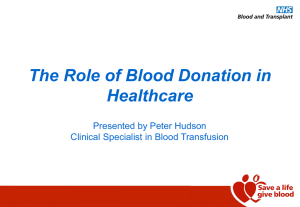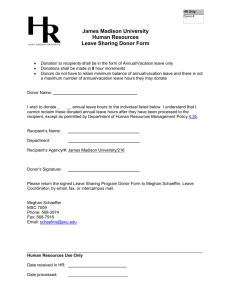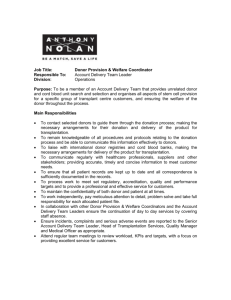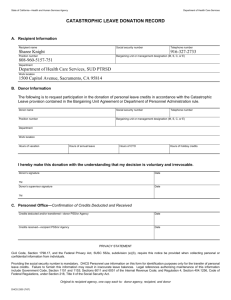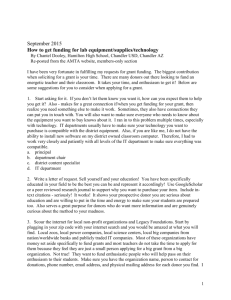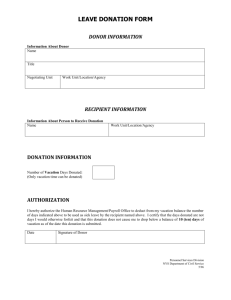Oocyte Donation – Information for Recipients
advertisement
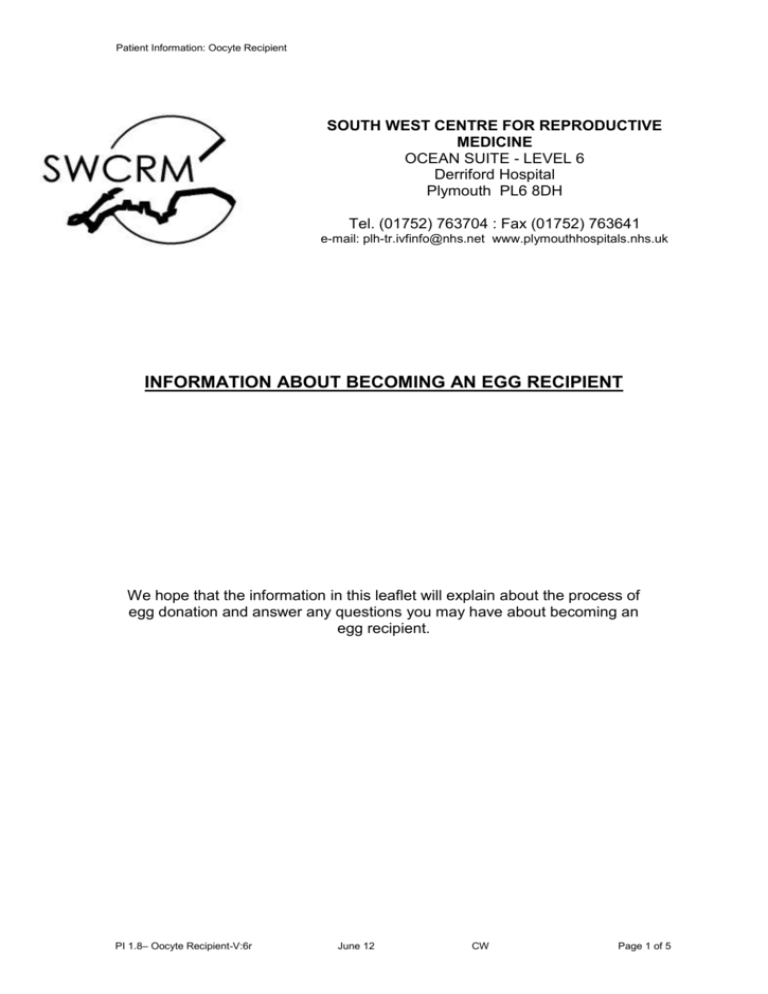
Patient Information: Oocyte Recipient SOUTH WEST CENTRE FOR REPRODUCTIVE MEDICINE OCEAN SUITE - LEVEL 6 Derriford Hospital Plymouth PL6 8DH Tel. (01752) 763704 : Fax (01752) 763641 e-mail: plh-tr.ivfinfo@nhs.net www.plymouthhospitals.nhs.uk INFORMATION ABOUT BECOMING AN EGG RECIPIENT We hope that the information in this leaflet will explain about the process of egg donation and answer any questions you may have about becoming an egg recipient. PI 1.8– Oocyte Recipient-V:6r June 12 CW Page 1 of 5 Patient Information: Oocyte Recipient Oocyte Donation – Information for Recipients Introduction Where a woman is unable to use her own eggs (oocytes) to have children, it is sometimes possible to use eggs that have been donated by another woman. These donated eggs are usually mixed with the recipient’s partner’s sperm, to create embryos. Sometimes donor sperm is used and embryos can also be donated instead of eggs. Once the fertilised eggs or embryos are successfully implanted in the recipient the pregnancy proceeds as normal. Oocyte Donation The egg donor has to volunteer to provide the eggs (oocytes), and this means to receive no payment other than expenses. There is usually a shortage of suitable donors available and therefore we have a waiting list for patients, such as yourself, requiring this treatment. Once a suitable donor is found, they are counselled, tested and matched as beat as possible to a recipient; the eggs are then recovered from the donor. The eggs are then mixed with the sperm of the recipient’s partner or a sperm donor to create embryos. Any embryos that are produced are then used in either a fresh embryo transfer or are frozen and used at a later date. Most of our donors approach the infertility unit on altruistic grounds as volunteers. Many are related or known to the recipient and wish to help them in achieving a pregnancy. They may also be patients who have undergone IVF treatment and who have more embryos than they need for themselves and have chosen to donate the surplus ones. Donors must be aged 18 – 35 with a normal ovarian reserve (Anti-mullerian Hormone), unless in exceptional circumstances, with no family history of a major inherited disease or disability, and have no transmissible disease such as Hepatitis B, C, Syphilis, Gonorrhoea or HIV (AIDS). Donors will also be screened for chromosome analysis and to determine whether they are carriers of Cystic Fibrosis. Donors from certain ethnic backgrounds or who have relevant family/personal history will also be screened for conditions such as Sickle-Cell and Thalassemia trait. All donors are also screened for Rubella, CMV and Chlamydia. This screening process is to protect not only the recipient but also any child that may be conceived as a result of this treatment. The initial screening process may find that a potential donor is not a suitable “match” for the recipient and therefore we will be unable to offer them treatment. We aim to get as close a match as possible between donor and recipient in terms of height, build, hair and eye colour and ethnic background. Usually, however, the shortage of donors restricts the choice and no guarantees can be made. PI 1.8– Oocyte Recipient-V:6r June 12 CW Page 2 of 5 Patient Information: Oocyte Recipient Risks The risk of acquiring an infectious disease such as HIV or Hepatitis is kept as low as possible by screening the donor, however recipients (especially those having a fresh cycle of treatment), should be aware there is still a small risk of exposure. Genetic disease is a possibility from any pregnancy although donors are carefully assessed for history of conditions that may be passed through generations. The risks are therefore similar to any couple embarking on a pregnancy with no known history of genetic disorders. Recipient Treatment Programme We accept patients to be egg recipients up until they are 47 years old. Treatment must be completed prior to your 48th birthday. You should make sure that you are in the best health for a future pregnancy. You should not smoke, your weight should be within normal limits and you should be taking folic acid tablets. Research has shown that by taking folic acid tablets 400 micrograms daily, pre-conceptually and up to 12 weeks of pregnancy, that conditions such as spina bifida may be prevented. We will have assessed the recipient’s partner’s sperm quality prior to the donor’s egg collection day to determine which treatment will offer the recipient couple the best chance of a pregnancy. This may mean that we will freeze a sample of sperm prior to the day that the eggs are obtained, as well as requesting a fresh sample on the day. Arrangements however will depend upon your individual medical circumstances as some patients may require the use of donor sperm. The sperm will be mixed with the eggs on the day of the egg collection and up to two resulting embryos replaced a few days later or frozen for later use. In order to ‘tie in’ your cycle as a recipient with your egg donor we ask you to take the oral contraceptive pill if medically appropriate. We then require the recipient to inject a drug everyday that will “shut down” your own hormones. We then give you drugs that will stimulate the lining of the womb to thicken it. We will also perform a trial embryo transfer to identify any possible difficulties that we may encounter. Ultrasound scans will determine whether the treatment is successful by measuring the growth of your womb lining (endometrium). The embryo transfer will then be performed when the endometrium is thick enough and at the appropriate time for your donor. We have to carefully coincide your cycle with that of the donor to hopefully prepare your womb lining to be ready at the same time. We always endeavour to allow you to have a fresh embryo transfer to increase your chances of a pregnancy but occasionally it may be necessary to create your embryos and freeze them for an embryo transfer at a later date. PI 1.8– Oocyte Recipient-V:6r June 12 CW Page 3 of 5 Patient Information: Oocyte Recipient Transferring the embryos is very straightforward and is very similar to having a cervical smear taken. Usually one or two embryos are transferred. After the transfer, it is necessary to take hormones to help support any developing pregnancy for the next few weeks. Success Rates Treatment success is obviously governed by individual circumstances and responses. The chance of a successful pregnancy after two embryos are transferred is the same as our standard IVF&ICSI rates. There is a chance that a successful pregnancy could result in a multiple pregnancy (please request our current figures). HFEA are keen for us to reduce our multiple birth rate therefore you maybe asked to consider an elective single embryo transfer (ESET). Further information can be found on the HFEA website. Legal Information Parenthood issues - By law, the woman delivering the baby is considered to be the baby’s mother, not the woman who donated the eggs. You as the egg recipient are the legal parent of the child and the donor cannot make a claim for or be responsible for the child. If the woman who is treated has a husband or male partner who gave his consent to the treatment, he is considered by law to be the baby’s father. If she has a female partner, she can obtain parental responsibility. Withdrawing consent - the egg donor can change her mind at any time about the use of her donated eggs up to the point of embryo transfer. This applies to any “surplus” embryos resulting from the egg donation that you have had frozen for your future use. The implications for you as a Recipient Registration with the Human Fertilisation & Embryology Authority (HFEA) and the law The HFEA is a body that regulates fertility treatment in the UK. It requires us to send them details of every donor. This includes their full name, current address, date of birth, physical characteristics (including ethnicity), your medical history, religion, occupation, skills, hobbies and interests. Donors will also be invited to write a description of themselves and a goodwill message to any child or children born as a result of their donation. They will be encouraged to include information about their education, achievements, values and life experiences. This is very important and enables you, if you wish, to talk to the children about their origins as they grow up. The donor details will be kept on a ‘register’ of donors held by the HFEA. The information is coded and is not available to the public. Only donor- conceived children over the age of 18 would have access to this information. PI 1.8– Oocyte Recipient-V:6r June 12 CW Page 4 of 5 Patient Information: Oocyte Recipient Donors are no longer anonymous. A change in the law in 2005 means that donors are no longer anonymous. The law was changed because it was felt that every person has a right to know the truth about his or her background. As a recipient you have to be prepared to accept that any child born as a result of donation can apply to HFEA at the age of 18 for details about their donor (including their name, address, date and place of birth). Donors themselves can also apply to the clinic or HFEA and find out how many children have been born as a result of their donation, how many are boys and how many are girls and the year of their birth. Donors have the right to withdraw consent up until the embryos created from their donation are transferred in treatment. Donors have no legal obligations to any child created from their donation. They will not be on the birth certificate or have any rights over the child nor will they have to contribute financially. Donors can say how they want their eggs used. An egg donor can be used to create children for a maximum of ten ‘families’. There is no limit on the number of children each family may have. Donors can, however, set their own lower limits on the number of families if they wish, which must not be exceeded. They can also specify certain conditions on the use of their eggs should they choose to do so, such as only for the use of a named person. Payments to donors The law sets out that all donations should be voluntary and unpaid (altruistic). The HFEA does allow donors to claim for all reasonable out-of-pocket expenses incurred as a result of their donation cycle such as travel costs, parking etc. Receipts for travel have to be kept, validated and presented for reimbursement. There is a maximum amount that can be claimed in any one cycle. For further Information: www.hfea.gov.uk Human Fertilization & Embryology Authority 020 7291 8200 www.ngdt.co.uk The National Gamete Donation Trust. 0845 226 9193 www.dcnetwork.org Donor Conception Network. 0208 8245 4369 PI 1.8– Oocyte Recipient-V:6r June 12 CW Page 5 of 5

